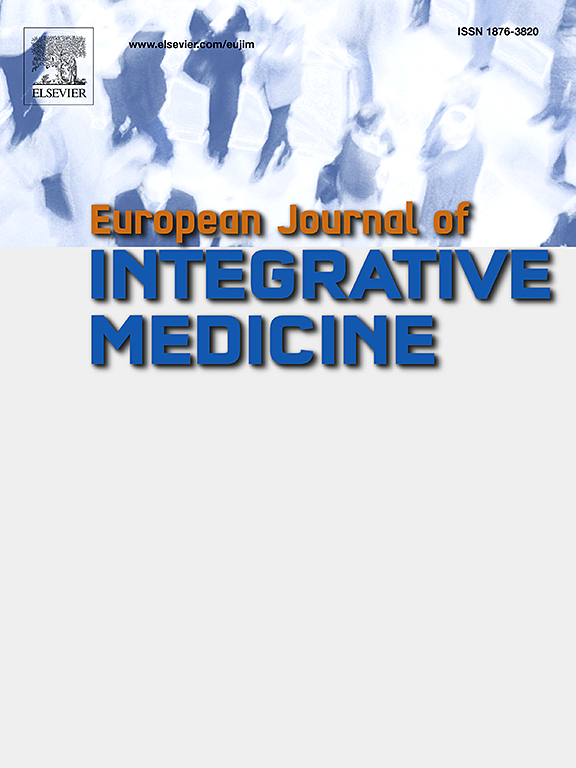The protective effect of chestnut honey against oxidative stress and cyto/genotoxicity produced by UVB irradiation established in vitro
IF 1.7
4区 医学
Q3 INTEGRATIVE & COMPLEMENTARY MEDICINE
引用次数: 0
Abstract
Introduction
Ultraviolet B (UVB) radiation is a physical agent ubiquitously present in the environment that triggers inflammatory processes, oxidative stress, and DNA instability, potentially leading to various pathological conditions and diseases. In this study, we assessed whether Croatian certified organic chestnut honey (CH), with high polyphenol content, has protective properties against UVB-induced oxidative and cyto/genotoxic effects and, if it could therefore be considered as a functional food or functional ingredient in cosmetic formulations.
Methods
Whole human peripheral blood and isolated lymphocytes were treated with CH in an amount relevant for potential dietary use and 10-fold higher before (pre-treatment) and after (post-treatment) exposure to UVB radiation at 2 kJ/m2. Oxidative stress markers [reactive oxygen species (ROS), glutathione (GSH), and lipid peroxidation] were measured in separated plasma. Cytotoxic effects in lymphocytes were studied using the fluorescent assay with acridine orange and ethidium bromide, including identification and quantification of apoptotic and necrotic cells. DNA damage in lymphocytes was evaluated using the alkaline comet assay.
Results
The tested CH showed a tendency to reduce oxidative stress in plasma induced by UVB radiation and reduced DNA damage in UVB-irradiated lymphocytes protecting them from cell death. Overall, these observed beneficial effects of CH were achieved at 1 mg/mL, which corresponds to the average daily intake both when applied as pre-treatment and post-treatment following UVB exposure.
Conclusion
The findings of this study provide preliminary evidence on the in vitro protective effects of the tested organic CH; however, further confirmatory research is needed.
研究了板栗蜜对UVB辐射引起的氧化应激和细胞/遗传毒性的保护作用
紫外线B (UVB)辐射是一种普遍存在于环境中的物理因子,可引发炎症过程、氧化应激和DNA不稳定,可能导致各种病理状况和疾病。在这项研究中,我们评估了克罗地亚认证的有机栗子蜂蜜(CH)是否具有高多酚含量,具有抗uvb诱导的氧化和细胞/基因毒性作用的保护特性,以及它是否因此可以被视为功能性食品或化妆品配方中的功能性成分。方法在暴露于2 kJ/m2的UVB辐射前(预处理)和后(处理后),用与潜在膳食用量相关的CH处理整个人外周血和分离淋巴细胞,其量高出10倍。在分离血浆中测定氧化应激标志物[活性氧(ROS)、谷胱甘肽(GSH)和脂质过氧化]。采用吖啶橙和溴化乙啶荧光法研究其对淋巴细胞的细胞毒作用,包括凋亡和坏死细胞的鉴定和定量。用碱性彗星法评价淋巴细胞DNA损伤。结果实验中所测CH有降低UVB辐射引起的血浆氧化应激的倾向,并减少UVB照射淋巴细胞DNA损伤,保护其免于细胞死亡。总的来说,这些观察到的有益效果是在1mg /mL时实现的,这相当于UVB暴露后作为前处理和后处理时的平均每日摄入量。结论本研究结果为有机CH的体外保护作用提供了初步证据;然而,还需要进一步的确证性研究。
本文章由计算机程序翻译,如有差异,请以英文原文为准。
求助全文
约1分钟内获得全文
求助全文
来源期刊

European Journal of Integrative Medicine
INTEGRATIVE & COMPLEMENTARY MEDICINE-
CiteScore
4.70
自引率
4.00%
发文量
102
审稿时长
33 days
期刊介绍:
The European Journal of Integrative Medicine (EuJIM) considers manuscripts from a wide range of complementary and integrative health care disciplines, with a particular focus on whole systems approaches, public health, self management and traditional medical systems. The journal strives to connect conventional medicine and evidence based complementary medicine. We encourage submissions reporting research with relevance for integrative clinical practice and interprofessional education.
EuJIM aims to be of interest to both conventional and integrative audiences, including healthcare practitioners, researchers, health care organisations, educationalists, and all those who seek objective and critical information on integrative medicine. To achieve this aim EuJIM provides an innovative international and interdisciplinary platform linking researchers and clinicians.
The journal focuses primarily on original research articles including systematic reviews, randomized controlled trials, other clinical studies, qualitative, observational and epidemiological studies. In addition we welcome short reviews, opinion articles and contributions relating to health services and policy, health economics and psychology.
 求助内容:
求助内容: 应助结果提醒方式:
应助结果提醒方式:


